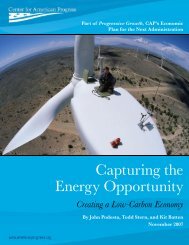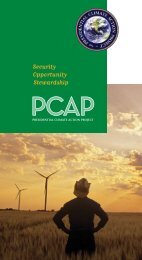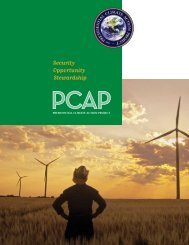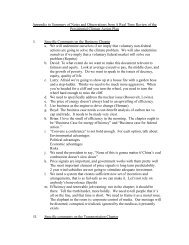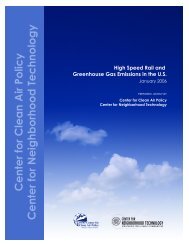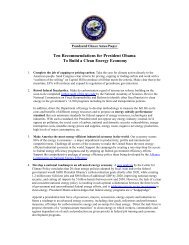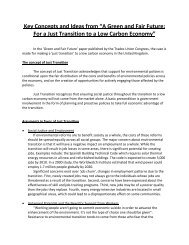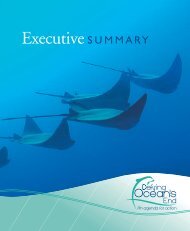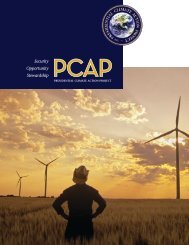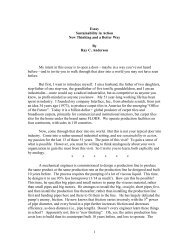The 2011 Plan - Presidential Climate Action Project
The 2011 Plan - Presidential Climate Action Project
The 2011 Plan - Presidential Climate Action Project
Create successful ePaper yourself
Turn your PDF publications into a flip-book with our unique Google optimized e-Paper software.
FRESH WATER RESOURCESWater is overtaking oil as our scarcest natural resource in the world.— Author Steven SolomonIn February 2010, Interior Secretary Ken Salazar announced WaterSMART, a strategy toimprove federal water policies to meet the demands of population growth, climate change,energy production, aging infrastructure, and environmental risks. Water is also a focusof the Administration’s Interagency <strong>Climate</strong> Change Adaptation Task Force. In October2010, it proposed a national action plan to “strengthen climate change adaptation forfreshwater resources”.<strong>The</strong> last time the federal government conducted a comprehensive national “water census” was 1978. But we knowthis much: We Americans are the biggest water consumers in the world; By 9 a.m. each morning, the average American has used 30 gallons of water. By bedtime, each of us hasused 150 gallons. By comparison, people in the United Kingdom use 40 gallons a day and people in Chinause 22 gallons; 56 Some U.S. cities with the lowest levels of rainfall have the highest water use and the lowest water rates; 57 Although it is often unpriced around the globe, water is “the most valuable stuff in the world.” 58 <strong>The</strong>re isno substitute; By mid-century, 45 percent of the world’s people (4 billion) are expected to live in places chronically shortof water.<strong>The</strong>re is an old saying by Mark Twain that is familiar in the American West: “Whiskey is for drinking; water is forfighting over.” <strong>The</strong> fighting has already begun. <strong>The</strong> U.S. Geologic Survey (USGS) reports that “water shortage anduse conflict have become more commonplace in many areas of the United States – even in normal water years –for irrigation of crops, for growing cities and communities, for energy production, and for the environment andspecies protected under the law”.When the Government Accountability Office surveyed state water officials in 2003, it found that 36 states wereanticipating water shortages within a decade, even without counting the anticipated impacts of climate change.In July 2010, the Natural Resources Defense Council (NRDC) estimated that more than 1,100 U.S. counties – onethirdof all the counties in the lower 48 states – are threatened with water shortages by mid-century as a resultof global warming. Fourteen states face extreme or high risk. 5956 “America’s Dwindling Water Supply,” CBS Reports, January 2010. www.cbsnews.com/stories/2010/01/08/eveningnews/main6073416.shtml.57 “<strong>The</strong> Price of Water: A Comparison of Water Rates, Usage in 30 U.S. Cities”, Circle of Blue, April 26, 2010.58 “For Want of a Drink”, <strong>The</strong> Economist, May 22, 2010, p. 3.59 Arizona, Arkansas, California, Colorado, Florida, Idaho, Kansas, Mississippi, Montana, Nebraska, Nevada, New Mexico, Oklahoma, and Texas.28



